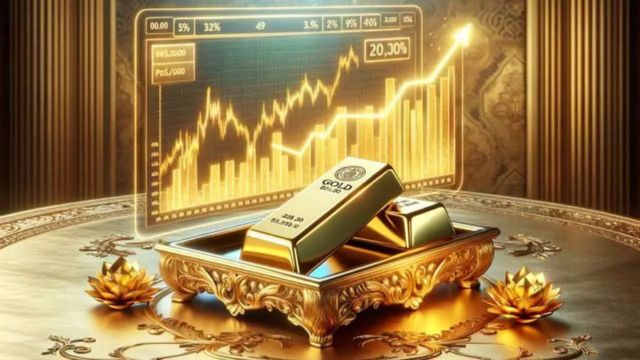Recent gold prices have reached all-time highs
In a shimmering testament to its enduring value, gold has recently reached unprecedented heights, reflecting not only its status as a cherished asset but also the complex interplay of global economic forces. The continuing ascent of gold prices, achieving a new zenith last Thursday, underscores the metal’s unwavering allure amidst fluctuating economic conditions.
Analysts, like Aakash Doshi from Citi, forecast a potential increase in gold prices to $2,300 per ounce by the latter half of 2024, driven by anticipations of rate cuts by the U.S. Federal Reserve. Currently trading at $2,203 per ounce, gold’s price trajectory seems poised for further elevation, bolstered by a series of economic and geopolitical factors.
Gold’s pricing dynamics often mirror the inverse movements of interest rates. As rates fall, gold emerges as a more attractive option compared to fixed-income assets like bonds, which tend to offer diminished returns in a low-interest environment. This relationship underscores the metal’s appeal during periods of monetary easing.
Market analysts, including those from Macquarie, predict continued upward momentum for gold, attributing recent surges partly to robust futures buying, alongside substantial physical acquisitions.
The physical demand for gold, especially from central banks, has been a significant driver. The World Gold Council highlights continued substantial purchases by central banks, which have historically bolstered market prices despite challenges like high interest rates and a robust U.S. dollar.
These central bank acquisitions, notably from entities like the People’s Bank of China and Poland’s central bank, reflect a diversified strategy towards bolstering financial security and mitigating geopolitical risks, such as those emanating from the ongoing Russia-Ukraine conflict.
China, in particular, has been at the forefront of both consumer demand and central bank purchases, indicating a robust national inclination towards the precious metal amidst economic and real estate uncertainties.
The appeal of gold extends beyond central banks to retail consumers, especially in regions like China and India, where cultural and economic factors fuel demand. China’s significant leap in gold jewelry purchases in 2023, outpacing even traditional leader India, underscores a widespread consumer shift towards tangible assets.
Meanwhile, India’s vibrant wedding season continues to spotlight gold’s cultural and financial significance, despite fluctuations in jewelry demand due to rising prices.
The global landscape, marked by inflationary pressures and political uncertainties, particularly in countries like Turkey, further accentuates gold’s safe-haven status. Turkey’s dramatic increase in gold demand amidst currency devaluation and inflation reflects the metal’s role as a stabilizing asset during tumultuous times.
As we look ahead, the trajectory of gold prices seems intertwined with a myriad of factors, from monetary policies and central bank activities to geopolitical tensions and consumer trends.
The enduring allure of gold, underscored by its recent price milestones, reflects a complex tapestry of economic resilience, cultural significance, and strategic asset allocation. As investors and consumers alike navigate through the uncertainties of the global economy, gold’s luminous path offers a beacon of stability and value, reinforcing its timeless appeal in an ever-changing world.











